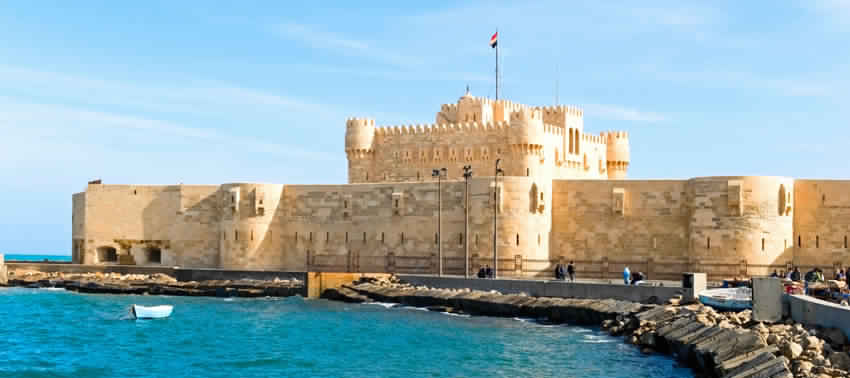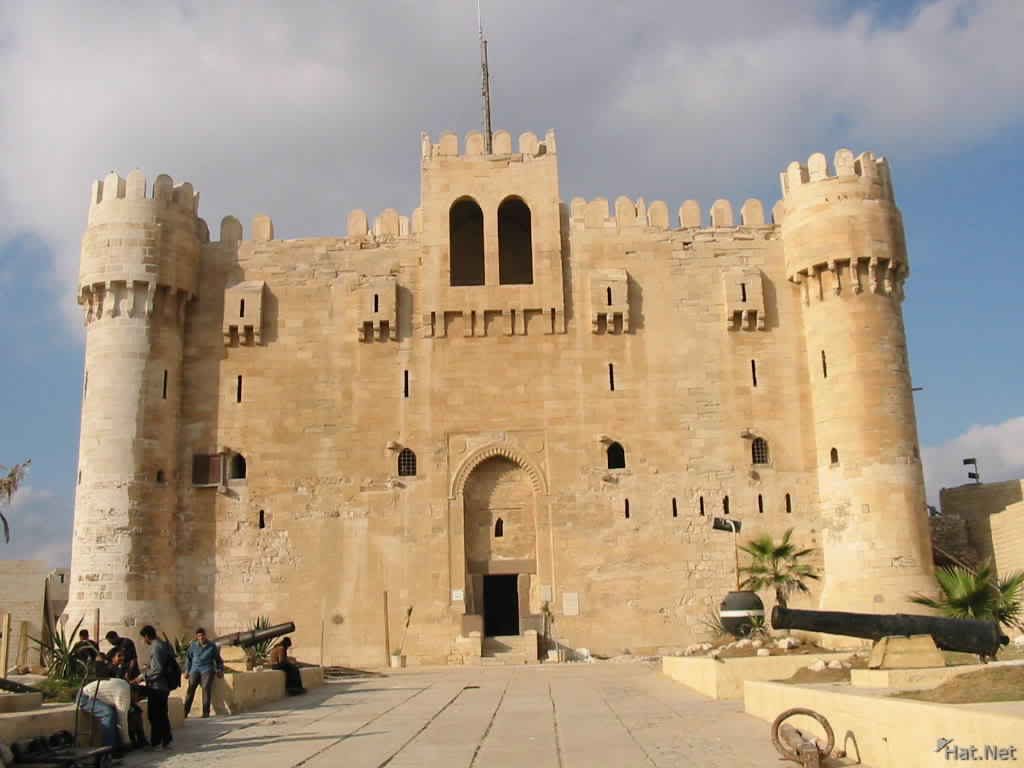Monuments Sight Seeing Attractions Qaitbey Fort
The island of Pharos was a major port having two huge harbors, Monuments Sight Seeing Attractions Qaitbey Fort was built in the 1480’s by Sultan Qaitbey, on the site of Alexandria’s ancient lighthouse, Parts of the remains of the lighthouse can be seen in the construction of the old fort.
One of the seven wonders of the ancient World, the lighthouse was an astonishing 125m in height with approximately three hundred rooms at the bottom for workers.
Running through the center was a double spiral ascent and hydraulic machinery that raised fuel to the top.
Monuments Sight Seeing Attractions Qaitbey Fort
The lantern at the top of the lighthouse remains a mystery.
Some say it contained a polished steel mirror that reflected light by day, and fire by night. Others say it was made of transparent glass.
The lantern and the top two stories fell around 700 AD according to many reports, and the rest of the lighthouse was destroyed by an earthquake around 1100.

In its place a Mosque was built, which was damaged by an earthquake in the 14th century.
The entrance is through a gateway made of red Aswan granite.
Located beside the mosque is a cistern that was used to store water in case of a siege.
Also located inside the fort is the Naval Museum which contains artifacts from the Roman and Napoleonic sea battles.
A brief history
Since 2001, Monuments Sight Seeing Attractions Qaitbey Fort has been the object of an overall study programme initiated by the CE Alex.
This harbour-front strongpoint was erected on the site of the famous Pharos lighthouse of Alexandria that had collapsed in the 14th century.
We have undertaken archaeological excavations in the heart of the monument and are now completing this work with a study of the construction and an analysis of the historical, literary and graphic sources.
This research has allowed us to determine eight different stages in the turbulent history of this fortress, the most important of which are dated to the Mameluke (1250-1517), Ottoman (1517-1798) and modern (19th-20th C.) periods.
The fort stands in the Anfoushi district, at the tip of a spit of land that marks the entrance to the eastern harbour, opposite the city itself. In antiquity this area was part of an island connected to the mainland by a causeway.
This was the ancient island of “Pharos” described by Homer in the Odyssey, “There is an island there in the heavy wash of the open sea, in front of Egypt, and they call it Pharos, as far out as the distance a hollow ship can make in a whole day’s sailing when a sharp and following wind is blowing it onward.” This strategic spot was absolutely fundamental for the defense of the city and for 16 centuries was dominated by the Pharos, and then by a medieval fortress.
Fort de Qaitbay, plan de situation
Qaitbay fortress,
is a fine example of military architecture from the Mameluke period in Egypt.
It was built in the 15th century on the orders of Sultan Ashraf Qaitbay, one of the last Mameluke rulers of Egypt, with the aim of protecting the city against the growing threat of the Ottoman Empire.
Ibn Iyas, a chronicler of that era, tells us that the sultan visited the site in 1477. “He wished to see the emplacement of the ancient Pharaohs and ordered the construction of a tower upon the old foundations, and it is there that was built the mighty keep that still stands.”
This new fort, with a central keep and defensive wall, was completed in two years – at the same time as the fort of Rosetta which the sultan had also commissioned.
Some 50 years later the fortress was already the object of important modifications; Sultan El-Ghoury erected a second curtain wall around the first to reinforce the strong point.
This was in vain as Egypt was conquered in 1517 by the Turks and was to remain an Ottoman province for the next three centuries. Qaitbay – Enceintes
Monuments Sight Seeing Attractions Qaitbey Fort
In 1798, Napoleon Bonaparte landed with 50,000 men and seized Alexandria.
His army was accompanied by 167 scholars who were to draw up a comprehensive record of all their discoveries in Egypt:
buildings ancient and modern, fauna, flora, terrain.
The soldiers found Qaitbay Fort in a bad state of disrepair and immediately set about its restoration
In the 19th century, the fort once again underwent important modifications.
During the reign of Mohamed Ali, the heavy artillery emplacements facing the sea were modernized.
A few decades later, at the time of Orabi’s revolt in 1882, the fort was seriously damaged by a British naval bombardment.
As a result, the local government felt it necessary to dismantle the upper parts of the keep.
qaitbay, donjon détruit.
The keep after dismantling in early 1904,
Comité de Conservation des Monuments de l’Art Arabe, Appendice au 25e fascicule, pl. III, 1908
Thanks to the work of the Committee for the Conservation of Arab Monuments, the keep was reconstructed in 1939.
The little Mameluke mosque within the main tower had been registered as a historic monument in 1888 and there was a desire to ensure its preservation.
Since that time, the fort has been well maintained, and today it is the only monument in Alexandria from the Mameluke period that is open to the public.
It is much visited by tourists. Qaitbay, donjon
Monuments Sight Seeing Attractions Qaitbey Fort
Today, the fortress looks as follows: the square set keep, with four circular turrets, is located in the north-eastern part of a vast courtyard.
Around the perimeter, the site is protected by a polygonal double defensive wall, against which are built some 40 small chambers that served as barracks.
To the north, facing the open sea, the walls are fortified by blockhouses that once housed cannons on two levels,
Contact us
[youtube_channel]
[gmap-embed id=”867″]


